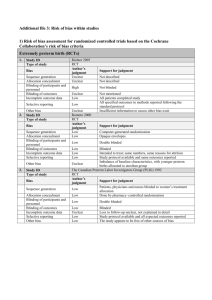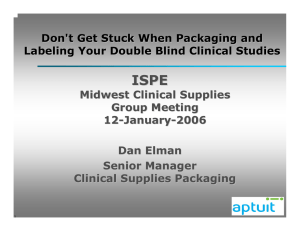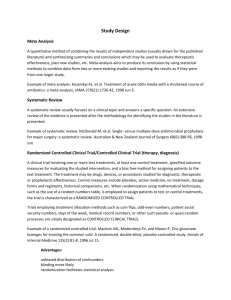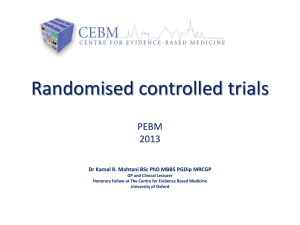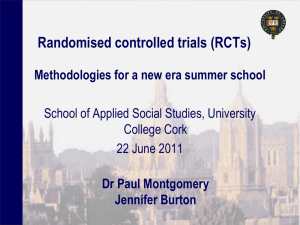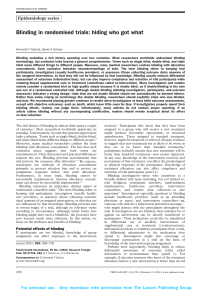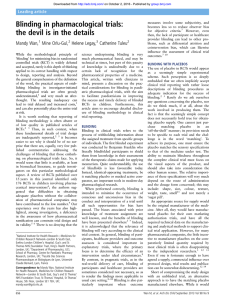The method of randomization was: Low risk if the investigators
advertisement
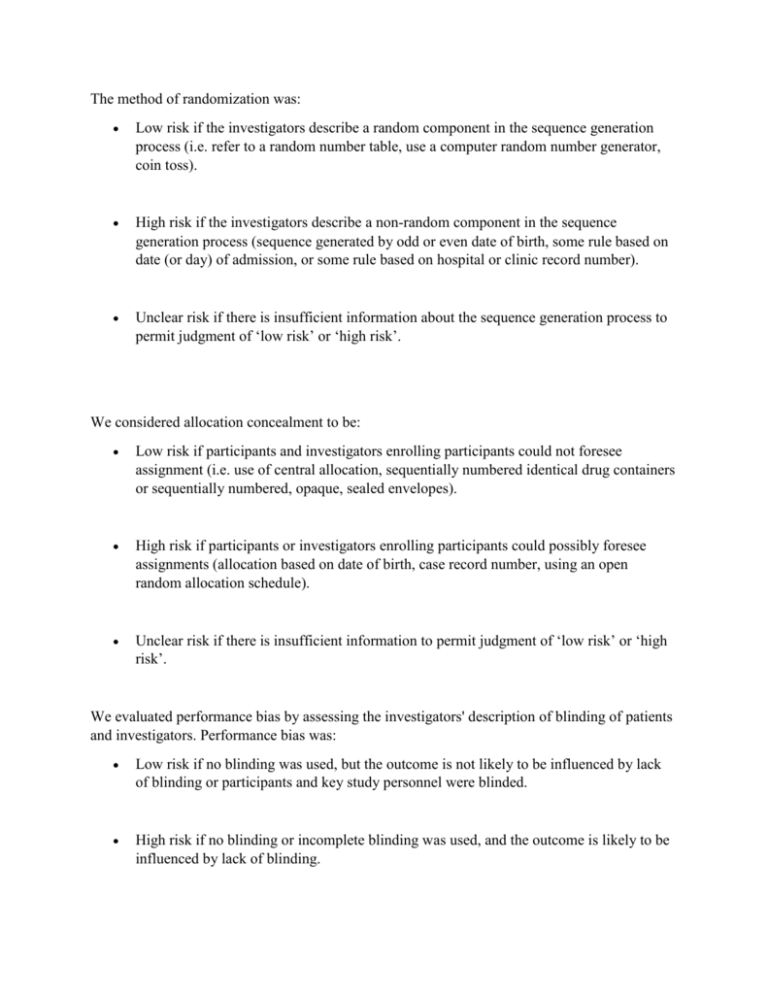
The method of randomization was: Low risk if the investigators describe a random component in the sequence generation process (i.e. refer to a random number table, use a computer random number generator, coin toss). High risk if the investigators describe a non-random component in the sequence generation process (sequence generated by odd or even date of birth, some rule based on date (or day) of admission, or some rule based on hospital or clinic record number). Unclear risk if there is insufficient information about the sequence generation process to permit judgment of ‘low risk’ or ‘high risk’. We considered allocation concealment to be: Low risk if participants and investigators enrolling participants could not foresee assignment (i.e. use of central allocation, sequentially numbered identical drug containers or sequentially numbered, opaque, sealed envelopes). High risk if participants or investigators enrolling participants could possibly foresee assignments (allocation based on date of birth, case record number, using an open random allocation schedule). Unclear risk if there is insufficient information to permit judgment of ‘low risk’ or ‘high risk’. We evaluated performance bias by assessing the investigators' description of blinding of patients and investigators. Performance bias was: Low risk if no blinding was used, but the outcome is not likely to be influenced by lack of blinding or participants and key study personnel were blinded. High risk if no blinding or incomplete blinding was used, and the outcome is likely to be influenced by lack of blinding. Unclear risk if there is insufficient information to permit judgment of ‘low risk’ or ‘high risk’. We judged detection bias due to knowledge of the allocated interventions by outcome assessors to be: Low risk if no blinding of outcome assessment was used, but the outcome measurement is not likely to be influenced by lack of blinding or blinding of outcome assessment was ensured; High risk if there was no blinding of outcome assessment, and the outcome measurement is likely to be influenced by lack of blinding Unclear risk if there is insufficient information to permit judgment of ‘low risk’ or ‘high risk.’ We judged attrition bias due to the amount, nature, or handling of incomplete outcome data to be: Low risk if there are no missing outcome data, reasons for missing outcome data are unlikely to be related to true outcome, or missing outcome data are balanced in numbers across intervention groups, with similar reasons for missing data across groups. High risk if the reasons for missing outcome data are likely to be related to true outcome, with either imbalance in numbers or reasons for missing data across intervention groups. For dichotomous outcome data, the proportion of missing outcomes compared with the observed event risk is enough to induce clinically relevant bias in the intervention effect estimate, or uses ‘as-treated’ analysis with substantial departure of the intervention received from that assigned at randomization or uses potentially inappropriate application of simple imputation. Unclear risk if there is insufficient reporting of attrition/exclusions to permit judgment of ‘low risk’ or ‘high risk’ (e.g. number randomized not stated, no reasons for missing data provided). We considered reporting bias due to selective outcome reporting to be: Low risk if the study protocol is available and all of the study’s pre-specified (primary and secondary) outcomes that are of interest in the review have been reported in the prespecified way or the study protocol is not available but it is clear that the published reports include all expected outcomes, including those that were pre-specified. High risk if the study’s pre-specified primary outcomes have not been reported, primary outcomes are reported using measurements that were not pre-specified, primary outcomes were not pre-specified, outcomes of interest in the review are reported incompletely so that they cannot be entered in a meta-analysis, or the study report fails to include results for a key outcome that would be expected to have been reported for such a study. Unclear if there is insufficient information to permit judgment of ‘low risk’ or ‘high risk.’ For the evaluation of risk or random error, we captured whether investigators report predetermined effect difference, alpha, power, and sample size calculation (yes/no and reported values) and if they were able to enroll the pre-specified number of patients (pre-specified sample size versus total number enrolled per arm).
